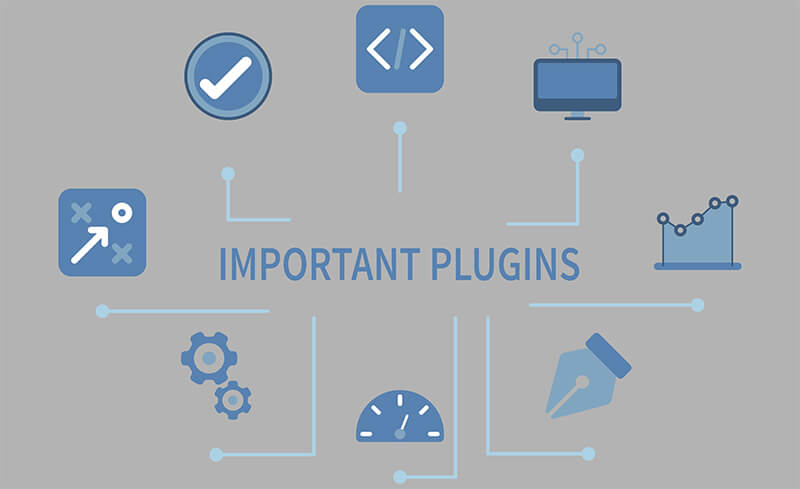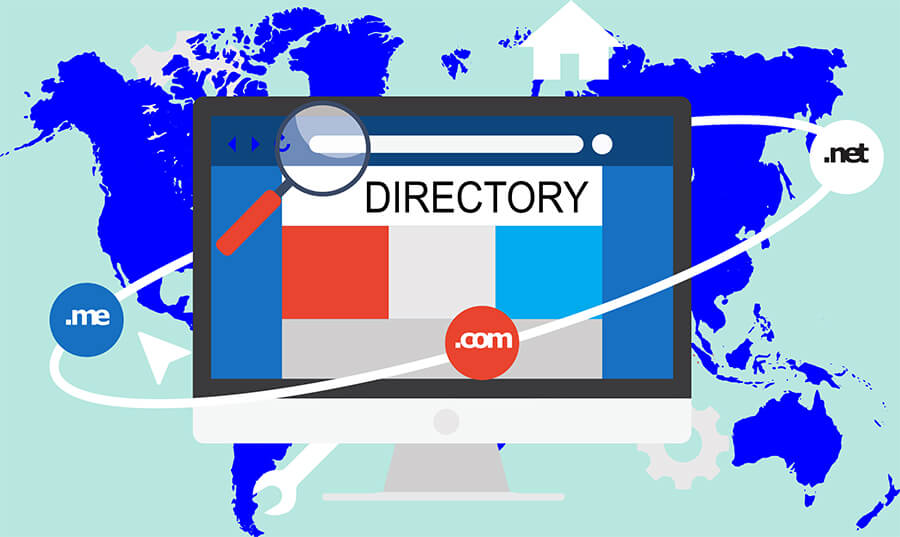To create a directory using WordPress you will just need your domain and hosting, installing a directory theme or plugin. The next steps will be to build your directory’s categories, customizing the submission form fields and creating listing submission packages. That’s the process of how to create a directory website using WordPress in a nutshell.
In this article, we aim to walk you through all the steps of how you can easily start a directory. We will take you through the (A-Z) of building your own directory. We will guide you starting with, choosing a domain, hosting, theme or plugin. We won’t leave you stranded after these basic setup stages either. We will also cover the next and important steps to setup the WordPress directory and actually run it to be a successful stream of passive income for you.
TABLE OF CONTENTS
1. Choosing the domain for your directory
2. Choosing the best web hosting company for your directory
3. Selecting the best platform to create a directory
4. Important features to look for in a directory theme or plugin
5. Choosing the right niche or multi-niche for your directory
6. Setting up categories that attract more traffic
7. Deciding what type of submission plans to offer
8. Create a landing page for your directory
9. Alternative ways to monetize your directory
10. Securing your WordPress directory
11. Optimize your directory for search engines (SEO)
12. Speed optimizing your directory website
13. Maintaining your directory
14. Important plugins to install
15. Promoting your directory on social media
The complete (A-Z) step-by-step guide on how to create a directory website using WordPress
Creating a directory doesn’t have to be complicated at all. You can follow these easy steps and be on your way to generate passive income from your directory. You will find some of the following steps to create a directory are optional, and some are either or steps. At the end of this tutorial, you will be able to get your directory website online and start generating revenue from it.

1. Choosing the domain for your directory
The domain you choose for your directory will undoubtedly play a major role in your branding and SEO. Choosing a domain name for your directory doesn’t have to be expensive or complicated. Many hosting providers like Bluehost and many others will actually let you choose a domain for free with the hosting. Needless to say, the domain name you choose for your directory has to be available.
We have listed a few guidelines below and questions you can ask yourself when choosing a domain. No doubt you know this already, but once you purchase a domain, it’s almost impossible to get a refund from the hosting company or domain registrar – choose the domain very carefully.
Guidelines for choosing a domain for your directory
The price – You can still find a good domain name at the regular price these days which usually ranges from $10 – $20. The price will depend on where you buy the domain and whether or not there is a sale available at the time you buy. You can of course go for a special domain which usually starts from anything as little as $300 to thousands, tens of thousands or a Million Dollars or more. You’ll be good to go with a regular domain name for your directory – just spend the time to search for one that’s available.
Number of editions – Decide if your directory will need different editions at the start, later or if you don’t think you’ll be needing more than 1 edition. In other words, it will be a good idea to choose a general top level domain like directory. com if you plan on having an edition for different countries. This is in contrast to let’s say choosing something like usadirectory .com – in which case you will be stuck with just having a directory for the United States with a domain like that which has a location limit. If your directory for example is planned to be just for the United States, then a domain name with USA in it is fine. Just be aware that changing a domain name after a site has gone online and indexed by Google is possible, but definitely not fun. Changing a domain of a live site involves a lot of redirects, many hours of work and is generally not an advisable thing to do.
Sub-domains or sub-directories – Find out if the hosting provider you choose allows the creation of sub-domains or sub-directories. Either one of these methods might be what you’d want to do to have a different edition of your directory. You might want to use a sub-domain or sub-directory of your main domain to offer editions for different cities, countries, towns or even niches. The advantage of using sub-domains or sub-directories is obviously the cost. In other words, you won’t have to purchase a domain name every time you need to create a separate edition.
A general piece of advice is that if you create different editions, use a single WordPress installation for each edition.
The main advantages of using a single WordPress installation for each edition over using WordPress Multi-site are:
– Each edition will be running on its own MySQL database instead of all editions being on 1 database. Doing it this way, will help speed up your directory website. One simple reason for this is that there will be less queries on each database whenever a user is on your directory.
– Each edition’s MySQL database will be smaller and quicker. A smaller database also means it will be easier to manage backups of each directory edition. While we’re on the subject of backups, check if the hosting company you choose offers backups. Some hosting companies include it for free, some will charge you and some may not even offer backups. There are various other ways to do backups, jump to point (13) of this guide.
– Just in case your website has a technical problem or gets hacked, not all editions will be down since they’re not all on the same database.
– You can change the text strings of the theme and/or plugins on one edition to match the edition. This is for example if you have an edition for the USA, you can make the wording on a particular edition to match the USA. You cannot do this if you choose to use WordPress Multi-site where 1 change to the theme and/or plugins will apply to all sub-sites using them.

2. Choosing the best web hosting company for your directory
The web hosting you choose for your directory is one of the most important decisions you need to make. Ask anyone who has migrated a WordPress website from one hosting provider to another – they will tell you it’s not fun. It is exciting to be launching a directory and it’s easy to just want to get it all installed and jumping into the admin dashboard.
We highly recommend that you spend enough time researching for the best hosting plan you can afford. Making a mistake with the hosting right at the start is a mistake that you really don’t want to make.
Guidelines for choosing web hosting
– Spend enough time on research before deciding on the hosting company and plan.
– Try to choose hosting that offers free site files and database backups (not all hosts or plans offer free backups).
– Don’t go for the fastest and most expensive hosting plan at the beginning. Let your directory get off the ground first and gather traffic and generate some income. Upgrading your hosting plan at a later stage is the best way to go. Having said that, do be sure that the hosting company you choose has the option to upgrade the hosting plan.
– Choose a hosting company that’s known to have good security measures in place for WordPress websites. You wouldn’t want your directory website to be easily hacked simply because the hosting company doesn’t protect your website on server-level. With being said, don’t just rely on having your website hosted on secure hosting. We cover securing your WordPress directory website in point (10) later on in this guide.
– Always include in your research on the hosting for support. The last thing you want is to wait longer than what’s considered an average turn-around time for support to resolve issues. Your WordPress directory website will be a source of income for you at one point. The directory being a source of income for you is a great reason to pick a web hosting with fast support. You wouldn’t want your directory to be offline for too long (if it came to that).
You will need to do your own research on which type of hosting you need. The types of hosting below are just pointers for you to research on the main different types of hosting you can get your directory hosted on:
– SSD (Solid Disk Drive) hosting – can be shared, VPS or dedicated. SSD hosting is usually fast.
– WordPress hosting – This type of hosting is usually optimized for WordPress websites. Contrary to what its name suggests, although it has its advantages, this is not necessarily the only and best type hosting for WordPress websites. This type of hosting can be shared, VPS or dedicated and is usually affordable and a touch faster than the regular shared hosting.
– Cloud hosting – This type of hosting serves your website from different servers around the world/country. The number of servers your site is served from depends on the hosting company and plan you choose. Cloud hosting might be a good idea for a directory that serves more than one country. You can also refer to point (12) on this guide where we tell you about CloudFlare.
– VPS hosting (Virtual Private Hosting) – This is virtualized hosting where your website is hosted on multi-tenant cloud hosting. VPS is usually faster than shared hosting and it’s the level just under dedicated hosting. You’ll find that VPS hosting is much more expensive than shared hosting but cheaper than dedicated hosting.
– Dedicated hosting – As the name suggests, this type of hosting is the top level hosting. A website that’s hosted on a dedicated server obviously gets its own server with no other websites sharing the same resources. Dedicated hosting is obviously much faster as your website is not having to fight for resources on a shared server. Dedicated hosting is by far the most expensive but if it’s speed you’re after, then dedicating hosting is the one for you.
We cannot say it enough times, how important the hosting is to create a directory website using WordPress. At Templatic we always recommend Bluehost or SiteGround
for hosting your WordPress website.

3. Selecting the best platform to create a directory
Now that you have your domain and hosting, whether you’ll be using a directory theme or plugin is the next step. Using a theme or plugin to power the directory functions on your website really depends on what you’re looking for. Both of these methods are good – it just depends on how you wish to do it.
We have highlighted below the main differences, advantages and disadvantages of using a directory theme or directory plugin. Don’t forget, using a directory theme or plugin doesn’t affect the overall functionality of your website. The choice you make should be based on the following:
Using a directory theme
The advantages of using a directory theme
– Directory themes come with a complete website design with a header, footer and menus with listing functionalities.
– You only have to deal with one company for the design and directory functionalities. If you choose a plugin, you’ll usually be dealing with one company for support on the theme and with another for the plugin.
– There is no chance of a conflict between the theme your website runs on and a directory plugin you install.
– Using a theme with directory functionalities means you don’t need to worry about the design. If you use a directory plugin, you will need to spend some time to integrate the plugin’s listing pages to match your theme. This isn’t applicable in every case though. The integration really depends on the design of your theme and how the directory plugin’s design will match it. Ideally, you’d want both the design of the theme and the directory plugin to seamlessly blend together.
If you decide to use a theme, you can see the directory themes we have designed. All of the themes on the list are designed for general or different niche directory websites. The themes are a great solution for creating city guides, business or restaurant directories. You can also use any of the themes to launch a listings, events, jobs, real estate, classifieds directory website or for almost anything else. You can also check out the list of 40+ directory themes from other top theme developers.
The disadvantages of using a directory theme
– You will not be able to keep using the existing active theme on your website. In order to install a directory theme, you’ll need to make it the active one. Changing the active theme on a live website is not really something you’d want to do. The main reason why changing the theme on a live website is not a good idea is because the design and in some cases, the functionalities will also change.
– Installing a new theme on a live website could mean that all of your navigation menus will need to be re-done. As well as this, switching themes on a live website might also cancel/remove some widgets that you are using from the old theme. This is because some widgets or functions are theme-generated. Once you replace the active theme, any function that was coming from the theme will also be gone.
The way to get around the problem and to keep using the existing active theme without changing anything on your website:
– Create a sub-domain or sub-directory on your domain and install a new directory theme on that. Doing it this way, will let you keep your website as it is (design/functions) and the directory section can be created on its own new WordPress installation. With the new theme installed on either a sub-domain or sub-directory, you will simply just have to add a link in the menu of your main website to the new installation (the directory). You would obviously also want to link back from your directory installation back to your main website.
“VOILA” – Installing a new directory theme on a sub-domain or sub-directory means you can keep your website as it is.
If you are just starting your directory website from scratch, and not on an already existing website – you don’t have to worry about any of the above disadvantages.
Using a directory plugin
The advantages of using a directory plugin
– Directory plugins can be considered as the “Magic bullet” method of adding a directory to your website. Using a directory plugin is a great way of adding directory functions to your website without having to change the design or functionalities. That’s of course assuming that the plugin will play well with the theme on your website.
– Using a directory plugin can be as simple as installing it and then pasting a few shortcodes. Most of the good directory plugins out there display their directory functionalities through shortcode. All you need to do to get a plugin to show the listings, submission or categories is to simply paste a shortcode or two on a new page on your website.
We won’t go into this in great detail as each plugin works differently and has its own user/installation guide. Simply put, adding a directory to your website with a plugin is nothing more than pasting some shortcode on pages.
– All of the directory functions usually appear under 1 new section on your admin dashboard. This might not be a great advantage for websites that are only a directory website. The advantage becomes invaluable for more complex and multi-section websites. In other words, having one place in the admin dashboard to control all aspects of the directory makes life easier.
The disadvantages of using a directory plugin
– You will need to install a theme to get your directory website to have a design, navigation menu, header and footer. This isn’t a problem if you already have a website running on a theme and you’re looking to just add a directory functionalities with a plugin.
– You have to update the directory plugin as well as the active theme.
– There is more cost to creating your directory. Most good directory plugins are premium, not free. That’s in contrast of just paying for a directory theme.
– You’ll be adding an extra plugin to your website. In general, the less plugins you install, the faster a WordPress website loads.
– You might face some problems getting the plugin to work with your theme. As a general rule when using WordPress, not all plugins will work with all themes. Hopefully, you won’t have any conflict issues between plugin and theme.
– You might have to do some adjustments to the website’s CSS to get the plugin’s directory functionalities to seamlessly display. If you use a directory theme, you won’t have to worry about this.
If you decide to use a plugin, you might be interested in this particular directory plugin. This plugin works beautifully with most WordPress themes and in particular with the super-fast and popular Neve theme.

4. Important features to look for in a directory theme or plugin
Creating a successful directory very much depends on some features it needs to have. We recommend that you try to look for the following features and functionalities in either the directory theme or plugin. The features below will help you create a directory using WordPress that is easy to build and manage and a directory that will earn you passive income.
Multi-tier submission packages – Having the option to create submission packages with more features for paid packages over free ones will be great. Such a system should let you to for example allow a listing to have more text, images and fields, the more expensive the package is. Having a multi-tier is basically a great way to encourage submission to a paid or a more expensive package.
Custom fields – The directory theme or plugin you choose should let you easily create custom fields. Being able to create custom fields is an important option to have for flexibility. Adding new custom fields will basically let you create a directory for almost anything you like. Having niche-specific submission form fields will be vital in making your directory easy to customize as you build it.
Claim Listings – Allowing a business owner to claim a listing is a good way for generating revenue. You can either add listings manually or import them to your directory. Charging a business to claim a listing or encouraging upgrading a claimed listing is the idea.
Powerful search – Directories can sometimes be daunting for users to find information on. Providing search features is a great way to have a directory website that offers better user experience. Having advanced search is even better as it allows your users to refine their search.
Monetization packages – A directory theme or plugin that has options for flexible submission packages will prove invaluable. You will ideally go for a system that allows you to create regular submission or subscription type of packages. Subscription packages are great as they allow you to set 1 price and the package will include the number of submissions you decide it should allow.
Admin approval – This option is great if you don’t want any submitted listings to go live before you check them first. Almost all directory themes and plugins will have this feature – do check though before buying anything.
Custom post types – Being able to create different post types is a great option if you plan on having more than 1 section. With custom post types, you can for example have one post type for business listings and another for classified ads.
Multi-level categories – Having the option to add deeper level sub-categories will help you organize your directory’s categories more efficiently. Organized categories will make your directory easier to navigate and find businesses on for your users.
Payment gateways – The more payment gateways the theme or plugin let you choose from, the better. You will find that not all payment gateways work in all countries. Some payment gateways will actually only work in 1 or 2 countries. We recommend that you find out which payment gateway works in your country and see if the theme or plugin has that one. In some cases, you might be able to purchase additional payment gateways from the theme or plugin developer.
Notification emails – Any good directory system will have various email notifications. The emails will be sent to users on certain events like: on listing submission, on listing activation by admin, before a listing is about to expire and when a listing actually expires. Admin too should get email notifications when a user registers on the directory, submits a listing, edits a listing. Other useful emails for admin will be when a listing is paid for or upgraded.
Scalability – Try to choose a theme or plugin for your directory that you can expand. In most cases, whether it’s a theme or plugin, the developer should have extra add-on plugins that you can download or purchase. As no two directories are ever the same, add-on plugins are a great way to add functions to a directory. The only downside is that most add-ons will come at an extra cost. The upside to using add-ons is that you don’t get a theme or plugin which includes functions you will never use. The last thing you want is to have way more functions than your directory needs. The more functions, the more the code is bigger and the slower the website is. Add-ons are great because you can basically choose the extra functionalities your directory needs and just by the add-ons with those extra functions.
Website Loading Speed – No matter if you choose a theme or plugin to create your directory in WordPress, it should be fast to load. Nobody these days is used to waiting more than 3-5 seconds for any website to load. Choosing a slow platform to build your directory will most certainly reduce traffic on your website and that of course means less revenue.
SEO friendly – Always pay close attention to the URL structure of the directory platform you’re considering. Whether it’s a theme or plugin, your directory should have SEO friendly URLs. The system you go for should also be compatible with the Yoast SEO or the All In One SEO plugins. Both of these SEO plugins are free and they also have a Pro version.

5. Choosing the right niche or multi-niche for your directory
Deciding on the niche your directory targets will help you have a clear plan on building it. There are many types of directories that you can create using WordPress. Therefore, you need to decide what niche your directory will be targeting from the start. In addition, you will be doing unnecessary work to make changes later if you don’t have a clear plan from the start.
To make choosing the niche for your directory easier, consider the following points:
Do some research to find out if there is a need for the niche you plan to have a directory website for. You can use some online tools that show keyword search volume to conduct your research like:
Google Trends
Semrush
Ahrefs Keyword Explorer
– Decide if you want to have a directory for just 1 niche or several niches.
– Think about if your directory going to be for 1 location or several locations.
– Visit several directories that cover the niche you plan on serving. Check if the directories you are looking at have a good amount of listings. The number of listings can be a good indication to see if there is demand or not for the niche you are researching. It’s worth mentioning that it’s possible for you to dominate a niche with a directory if nobody else has done covered the niche. In other words, just because there aren’t any or many directories covering a niche, doesn’t necessarily mean it’s not worth covering.
– Do you know enough about the niche to write plenty of blog posts about it? It will help if you do know about about the niche. You can drive a lot of traffic to your directory if you start writing lots of blog posts about the niche.
– Decide if you want to really niche-down or not. An example of this is having a directory for let’s say fishing. This makes your niche “Fishing” and your directory is a fishing directory. You could niche-down and choose trout fishing which makes your directory website specific to “Trout fishing”. While you are in the fishing niche, your directory just specializes in “Trout fishing”. You can apply this example to any niche and find niche-down.
One of the great reasons of having a very special niche directory is scarcity. Put in other words, you will find less directories out there that cover trout fishing than ones that cover fishing.

6. Setting up categories that attract more traffic
Categories are a great way to attract traffic to your directory website. A good way of using categories for traffic is to create many of them. You can do this for example by having parent and sub-categories. Let’s take for example a parent category called “Home & Garden”. As sub-categories to this parent category; you can have sub-categories such as:
Bathrooms
Blinds
Ceramics
Flooring
Garden Centers
You can create tens or even hundreds of sub-categories under each parent category. These above are just a very quick example.
The way to optimize each category and sub-category for search engines is simple. The most important thing for each category and sub-category to have its unique:
SEO title
SEO Meta Description
On-page description. (this is the description you enter in the WordPress dashboard when you create each category.
It’s noteworthy that Google and other search engines do not give great weight to categories as they did before. Having said that, categories can still be an extra way of driving traffic to your directory if you SEO them properly.

7. Deciding what type of submission plans to offer
When it comes to monetization, using WordPress to create a directory is the same as building one with other platforms. The basic principle of creating submission plans is to encourage a business to pay you to be on your directory. You can choose from several ways to make the packages on your directory work to generate income for you.
The different ways to structure your submission plans:
Create free and paid plans – Free plans attract plenty of free listing submissions and will make your directory look busy. Having loads of listings gives confidence for businesses to add a listing to your directory on paid plans.
Multi-tier plans – Create different paid plans with more expensive plans that offer more options. You can use this method for example to create 3 plans that give more features as the plan gets higher:
Bronze Plan $40
– Business Logo
– No gallery images
– Listing description (100 words max)
– Telephone number
Silver Plan $70
– Business Logo
– 4 gallery images
– Listing description (400 words max)
– Telephone number
Gold Plan $100
– Business Logo
– 10 gallery images
– Listing description (1000 words max)
– Telephone number
– Website address
– Facebook
– LinkedIn
– Instagram
Having different level plans is one of the ways to encourage a business to pay more when submitting. You need to check if the directory theme or plugin has a Multi-tier package option.
Offer options to upgrade a plan – You’d want to make it possible for a business to be able to upgrade a listing. Upgrading the plan a listing is on is one of the possible ways to earn more money from your directory. Sometimes a business can be encouraged to add more text for example if the listing is doing well on Google. The trick is to make it as easy as possible to upgrade a listing after it was submitted on a plan.
Only offer free listing submission plans – You can also make your directory totally free to submit listings on. If you choose this option, you’ll be getting the traffic and should find a way to monetize the website. We give you some ideas below in point (9) on alternative ways of how to monetize a directory website.
Claim listing – Activate the claim listing option if the system you use has it. You will find that some businesses from the ones you’ve added as admin will claim their listing. Adding listings as admin when starting a directory is a popular way to kick-start it. When you do this, the amount of listings on your directory should work to encourage businesses to actually pay you to appear on your directory.

8. Create a landing page for your directory
Now that you’ve created your directory, it’s time to create a landing page for it. The landing page can be the homepage of your website or even an inside page. No matter where the page appears, it should be linked from your website’s navigation menu. So the landing page needs to either be the homepage of your website or wherever else you want it to be. The important thing here is that the page is easy to find.
The content of your landing page should be informative and attractively designed. The purpose of having a landing page is to attract businesses to submit on your directory. The landing page would ideally have a hero banner at the top with short titles and a CTA button. Writing an introduction under the hero banner that clearly and quickly explains what the website is a great way grab a user’s attention. The content you include should encourage them to scroll further down the page and learn about the benefits of submitting on your directory.
Creating effective landing pages is another science altogether. In general, your landing page should be written and designed in a way to attract users to submit listings. Another way to think about the landing page is to consider it as a printed flyer that advertises your directory. With this in mind, try to fit much concise and clear information as possible on the page.
A successful landing page for your directory would have:
– Clear, informative and not confusing content.
– The right number of strategically placed CTA buttons.
– A list of the highlights of benefits of submitting a listing to the directory.
– Attractive design that doesn’t reduce the page’s loading speed.
– Wrote the page content for people, not search engines. In other words, create content that highlights and explains the benefits of submitting to your directory.

9. Alternative ways to monetize your directory
You can think of business directories as a possible stream of passive income. Having said that, do not confuse “passive income” with not having to do anything and that income will come. You still have to work, even after creating your directory in WordPress or any other platform. Let’s face it, not every online directory is going to see profits that go through the roof from listing submissions. Don’t be put off by this – you can consider some of the following alternative methods below to monetize your directory.
AdSense – You can place AdSense display ads, In-feed ads, In-article ads. Assuming your directory website generates plenty of traffic, you should be able to generate some income from AdSense. You won’t get rich from the revenue, but at least it’s some money coming in.
Affiliate ads – Another way to make money from your directory is affiliate ads. Deepening on the niche of your directory, you can consider placing affiliate ads and/or links. Making money from affiliate programs usually requires writing blog posts to drive traffic to a website.
If blogging is not your thing, you can try it another way. You can for example choose relevant affiliate products that appear on each directory category. Let’s say for example you’ve created a listing category called “Lawn Mowers”. This category would be a great place to place affiliate ads that advertise lawn mowers right? This is just an example, you can use the same model for all other directory categories.
You should be able to simply place your affiliate links or banners in each listing category’s description. Affiliate banners or links can also be placed in the sidebar of your directory. Since you have used WordPress to create the directory, using a plugin should do the magic. Try to find a plugin that lets you create custom sidebars. With the plugin installed, you can create a custom sidebar for each listing category. Now, place your category-relevant affiliate code in the category’s custom sidebar. This is at least a couple of ways of doing it.
Sell banner space – Selling banners is one of the ways to make money from a business directory. Let’s assume that your directory is getting a lot of traffic. Selling banner space can actually earn you a decent amount of money. Banner space is almost always priced according to how much traffic a website gets. As well this, the position of a banner and how many times it gets impressions is a factor in its placement what you should charge for it.
Charge for guest posts – Once your directory builds up traffic, it can attract a lot of guest post requests. If you decide not to have a blog on your directory, this method of making money might not work. To make it possible to charge for guest posts, you’ll need to have create a blog on the website. Considering you’ve used WordPress to build the directory, the blog is already there in the admin dashboard.
Make your blog encouraging enough for someone to want to submit guest posts to it. Having a wide range of topics and blog posts that are related to your directory’s niche is the best way. Okay, let’s face it, not everybody is born to be a writer. You don’t actually have to write blog posts yourself. There is no law that says that you can’t pay someone to write on your blog. Having a freelance writer filling your blog with posts is one of the ways you can have blog articles without writing them yourself. The police won’t come to your door or anything if you hire a freelancer to do the writing 🙂 It’s your blog and you decide who writes on it right?
Get your directory sponsored – Getting a business to sponsor your directory might also be one of the ways to monetize it. Okay, it’s easier said than done, but it’s not outside the realm of possibility. Only try to approach a business to sponsor your directory if it has traffic.
(Reached this far? Congratulations 🙂 make yourself a large cup of coffee and come read the next bit twice)

10. Securing your WordPress directory
Never underestimate the importance of securing your directory website. You can throw all other tips in this guide out of the window, except for this one.
Since you wanted to know how to build a directory with WordPress, the chances are, you’re after some extra income. Making sure your directory stays online and that it doesn’t get hacked should be your absolute top priority. You will not enjoy a second knowing that your website is offline after a hack.
Keeping any WordPress website secure, or let’s just say more difficult to hack, is easy. You can follow some or all of the tips below to keep your website more secure.
Before we dive right in, it’s worth mentioning that the tips below are not in any way the only steps to secure your WordPress website. We had to say this as a disclaimer of course. Having said that, if you follow the following steps, you’ll certainly be making a hacker’s life ten times harder.
Install a security plugin – Doing this should be the very first step once you’ve installed WordPress. No joke, you should really install a security plugin the second your WordPress site is online. We are not their affiliates or anything, but we recommend the free Wordfence security plugin. Wordfence also has a Pro version with some extra level of protection. You will of course also find plenty of other security plugins out there.
Hide that your directory is built using WordPress – One of the ways of keeping your site safe from hackers, is to hide that it’s using WordPress. So you’re looking at security through obscurity (STO). The way this is effective is because if a hacker cannot detect that your directory is using WordPress, it’s invisible to the detection tools hackers use.
Do you have to do any coding to hide that your website is running on WordPress? No, you don’t. You can simply install the popular Hide My WP plugin and it will do all the magic. The Hide My WP plugin is not free but it’s very reasonably priced. As the plugin gives your directory an extra level of security, it’s really not a lot to pay.
Link your directory to CloudFlare – You can add your website to CloudFlare. Once your site is linked, not only will it get extra security that CloudFlare offers, it can also run faster. It’s free to link your website to CloudFlare but their premium plans do offer many extra features.
Disallow plugin modification – Make it impossible for a hacker who gets into your dashboard to install new plugins or delete installed ones. As plugins are designed to do different things, the last thing you want a hacker to be able to do is to install plugins. There is for example a plugin or two out there that add a file manager to your WordPress dashboard. Having this plugin installed is just like having FTP access through the dashboard.
To disable plugin modifications or the ability to install new ones, edit your config.php file and add the following line at the very end.
define('DISALLOW_FILE_MODS',true);
Disable Theme File Editor – As crazy as it sounds, there is actually an option to access theme files right inside the admin dashboard. You can find this on Appearance >> Theme File Editor. If you can find it in the dashboard, so can a hacker who gains access to your admin dashboard.
Unless you have a very good reason, do not leave this option active in the WordPress admin dashboard. As the website owner, you already have access to theme and all other files through FTP or in the hosting’s file manger.
To disable the theme file editor, edit your config.php file and add the following line at the very end.
define( 'DISALLOW_FILE_EDIT', true );
Disallow access to wp-admin – You can ban access by IP to the wp-admin part of your website. The way to do this is by whitelisting the IPs that are allowed to access the wp-admin area. This method of security is easily done by adding a htacess file inside the wp-admin folder.
You can paste the code below into the htaccess file and upload the file by FTP/File Manager to the wp-admin folder. You can whitelist more than one IP address on the htaccess file. To add more, just add copy and paste ”allow from 1.206.102.203” and paste it on another line and change the IP address.
# Restrict access to wp-admin by IP
order deny,allow
# Replace the 1.206.102.203 with your the IP address you wish to give access to
deny from all
allow from 1.206.102.203
Important: The htaccess file might not work on all hosting servers. You might also not be able restrict access to wp-admin if the directory plugin or theme you use requires “wp-admin” in the URL for users. In some cases, this will be required for a user to edit a listing for example.

11. Optimize your directory for search engines (SEO)
SEO is by far, one the most important factors that determines if your directory will succeed or fail. You should easily be able to optimize your website with these quick tips on SEO. The tips below are in designed to just tell you about the basic things you need to do. We will cover SEO for your directory in our next detailed guide.
Install the Yoast SEO plugin – This plugin is our recommended plugin for SEO. Once you install the Yoast plugin, you are ready to start working on your Directory’s SEO.
Enter SEO titles – Make sure to enter a descriptive SEO title for all pages, listings and blog posts on your website. The Yoast SEO plugin has on-page SEO analysis which will help you get the title at the right length.
It’s advisable to also add a good descriptive SEO title to any listing that gets submitted on your directory. Listings that have good SEO will appear on Google. As a result, other businesses who are considering submitting to a directory or researching the competition will see the listing in the Google search results. Hopefully, other businesses would also want to be on your directory.
“Why would a business want to submit to my directory?” you’re thinking right? – It’s simple. Imagine a dentist for example who’s searching Google to find where his/her competitors appear in the results. Now imagine that one of the dentist’s competitors has submitted a listing on your directory and that listing ranks well on Google. Because of this, the dentist is more likely to consider also adding a listing to your directory to appear on Google too.
Enter SEO Meta descriptions – As above with SEO titles, meta descriptions need to be entered for each page, listing or blog post. We don’t want to turn this into a detailed SEO guide but SEO titles, meta descriptions and the content all work together when it comes to ranking. A good meta description will be as descriptive as possible about the page, listing or post. You can follow the Yoast plugin’s SEO analysis to check if the length of the description is correct. Pay close attention to the SEO analysis as it will guide you on other things you should do to get abetter ranking.
Content is still king – Write good content for people, not search engines. Make the content on any page of your website talk to readers and forget search engines. Well, not altogether but forget about keyword-stuffing and repeating the same keywords over and over. These techniques no longer work and Google will actually penalize your site of you use any of these old techniques.
Always try to focus on giving value to your users with your content. When you do that, Google and other search engines will give your website better rankings. Content that is well-written and informative gives an overall good user-experience. A page gets much of its ranking score from how users interact with it. This basically means that if your content is good, readers will stay longer on the page to read it. Google will rate see this as a positive signal and is then more likely to give the page a better ranking score.
Optimize page loading speed – You should pay special attention to your website’s loading speed. The performance of any website plays a vital role in any website’s ranking. The loading speed of your directory is very important since it’s related to a good user-experience. So you can consider a fast-loading website will contribute to achieving better ranking on Google and other search engines.
(More on improving the loading speed of your WordPress directory in step (12) below)
Install Google Analytics – Getting accurate traffic statistics is essential in understanding how your directory is performing. As no directory will ever succeed without traffic, adding Google Analytics will help you keep track of the traffic an understanding what drives it to your website. You should closely monitor the traffic statistics and see which pages and keywords generate the most traffic to your directory. The trick is to do more of the content that generates the most volume of traffic. As well as this, Google Analytics will help you get an in-depth view of the overall view of what drives traffic to your website.

12. Speed optimizing your directory website
Since the speed of your website is very important for SEO, you can consider loading speed as a top priority. You can do a lot of things that will help speed up your website. The great thing about using WordPress to build a directory is that you’ll find plenty of free plugins to optimize it.
The steps below give you some ideas on how to make your website load faster.
(Before we jump right in, let’s agree that in order to make your website load faster, you will need to do these steps as the absolute minimum.)
WordPress website Speed basics – Follow these 4 tips as the absolute minimum to optimize the speed of your directory. The same 4 tips also apply to any WordPress website for that matter, not just directory websites.
- Only host your website on the fastest hosting your budget will allow.
- Only install a WordPress theme that’s coded with speed in mind.
- Only install plugins that do not slow your website down. If any slow it down, uninstall and delete those plugins.
- Only install the plugins that are absolutely necessary for your directory. The more plugins you install, the slower the website will get.
Install a caching plugin – Since you’ve created the directory in WordPress, installing a caching plugin will help. You can choose from any of the best WordPress caching plugins to install the one you like the most. A caching plugin is great at speeding up a WordPress website.
A caching plugin basically serves a user a cached version of pages instead of serving them from the origin server (hosting) every time. In other words, when a user visits a page on your directory for the first time, the page is saved in the user’s browser cache. The next time the users visits that page, the user will be served the page from browser cache. The result is a much faster page load speed since the user will not have to wait for the page to come from the origin server. Caching plugins are one of the best ways to improve the speed of any WordPress website.
Optimize images – Always optimize any image that you add to your directory website. There are several of image optimization plugins that auto-optimize images as they are uploaded to the WordPress Media Library. You can also use many online tools like tiny jpg to optimize an image before uploading it.
Optimize website code – You can further optimize the theme and plugin code to speed your WordPress website. The easy way to do this is to use a plugin that will do the optimization like Asset CleanUp. This optimization plugin usually does an amazing job to speed up a WordPress website. Asset CleanUp offer you loads of optimization settings, with some being free and some are only available in the Pro version. We found that the free version of this plugin does a great job. Upgrading to the Pro version is really up to you.
Once you install this plugin, you will be able to activate options that will increase the speed of your directory website. We strongly advise you not to start activating every single option this plugin provides. The safest way applying the optimization options of the plugin is to activate them one-by-one. As some of the options can break your website, always check that your website is working well after you activate any of the plugin’s options. This is just the way things work with any optimization plugin.
Optimization options of any plugin can sometimes conflict with a theme or plugin that’s installed on any website. The basic rule when you use any optimization plugin, is to check that your website is working with every option you activate.
Activate lazy loading – This function can be in a theme or plugin and can considerably speed up page loading speed. The way lazy loading works is by delaying the loading of resources on a page until the user is actually on the part of the page that has the resources.
A good example lazy loading is if your site has 3 images above the fold and more images under the fold. If you have activated lazy loading, only the 3 images that are above the fold will be loaded when a user visits your website. The next images on the page will only be loaded when the user scrolls the page past the fold.
The resources that can have lazy loading applied to them will depend on the theme or plugin you are using. You will find that most lazy loading plugins will apply lazy loading to images and videos but other page elements might also be included.
Link your website CloudFlare – Already mentioned above in the how to secure your directory section, CloudFlare will also speed up your directory. Once you link your website to CloudFlare, your directory will load from several CloudFlare servers around the world. You can read more on how this works on their website but in short, your website is not always loaded from the origin server so it’s a much faster loading time.
Having your website loading from different servers around the world will decrease the time it takes for the website to load. The best advice is that you should do your own speed testing, before and after linking your website to CloudFlare. Testing is advisable since we do not know what hosting you will use. It’s very possible that the hosting you have might have its own cloud servers – therefore, it’s best you do your own “before and after” speed testing.
Optimize the database – Keeping your directory website’s database optimized can help to increase site speed. Since you’ve built your directory using WordPress, you’ll find plenty of good plugins to optimize the MySQL database that runs WordPress. You can use one of the tried and tested plugins such as WP Optimize which has 1+ Million active installations and it’s free. You can also activate the plugin’s auto-optimize scheduler to automate the task of database optimized for you.
Monitor speed performance – After optimizing the speed of your directory, you’d want to check its performance regularly. To check the speed of your website, you’ll find there are plenty of online tools that give you a detailed analysis page loading speeds. Many of the website speed testing tools are free such as:
- GTmetrix – Tests website speed from different locations around the world. GTmetrix also lets you setup email alerts based on site speed events. For example, you can setup the alerts to email you if your directory’s loading speed takes longer than the number of seconds you enter.
- Pingdom – This is another one of the popular online website speed testing tools. This online free speed test tool also lets you test your website speed from different locations around the world.
- Google PageSpeed Insights – This is an important page performance testing tool from Google that you should use. You can test your website’s speed on this tool which will also give you suggestions for fixes if it finds any issues.

13. Maintaining your directory
Now that you know how to build a directory using WordPress, it’s important to maintain it. Directory websites are easy to maintain, just like any other WordPress website except with a few extra directory-specific maintenance tasks. We will cover below some of the most important things to do to keep your directory running well so you continue to get passive income from it.
Update your directory – Keep the WordPress version, theme and all plugins your directory runs on updated. As well as adding improvements to performance, some WordPress, a theme or plugin updates are security updates. To keep the performance and security of your directory up to scratch, we recommend you update it whenever an update is available.
Test your directory as a user – Make it a habit to test your directory as a user at least once a week. You can do this by going through the exact process a user would go through to browse your directory or to submit a listing on it. Testing in this way will let you detect any problems that your users might face on your directory website. You will not be able to see some problems if you are only viewing your directory while logged-in as admin.
Make regular backups – Always backup your directory just in case. No matter how much you’ve secured your website, a backup is a fast and sure way to recover from a hack. Backups are also great to have just in case something breaks on your website. Sometimes it’s much quicker to restore a website from backup instead of trying to figure out what broke it.
Here are a few ways to backup your directory website:
– Hosting backups – Depending on the hosting provider and plan, there might be automatic backups. Backups by hosting companies are usually done daily. You should check with your hosting company if your plan includes backups and at what intervals are they made.
– Backup plugins – There are many backup plugins that will create a backup of your directory. The WordPress plugin repository has a few good backup plugins that you can choose from. Most backup plugins are free but for full backup functions, you’ll need the Pro/Premium version.
– Create manual backups – Providing you have access to FTP and the database for your directory, manual backups are simple. To backup the files, simply connect to your website by FTP/File Manager and download all files. To make a full backup, you will also need to backup the MySQL database. It depends on the hosting you have but exporting the database using phpMyAdmin is all there is to it.
– Backup listings – Some directory themes and plugins include export options. It might also be worth creating a backup of the listings on your directory. Some export tools will also let you export other things like; listing categories, packages, users etc.

14. Important plugins to install
Installing the following plugins will add important and useful functions to your directory. All of the plugins below are free and you can simply search for them on the WordPress plugins repository and install. Although not compulsory, these plugins will prove invaluable when creating a directory with WordPress.
We have already mentioned some of these plugins earlier in this guide. To help you, here are all of the plugins that will help you build your directory:
Wordfence – Keep your directory website protected against hackers. This is by far one of the best security plugins out there.
Yoast SEO – Optimize your directory for search engines with this popular SEO plugin.
GDPR Cookie Compliance – Stay on the right side of the European and other cookie law and consent notice law requirements.
Welcome Email Editor – You can customize the WordPress registration emails. This is great if you want to include custom message to users who register on your directory.
WP Asset CleanUp – Install this plugin to optimize your directory’s speed. You will find many amazing speed optimization options, even in the free version of this plugin.
WP Optimize – Put your directory’s database optimization tasks in autopilot. Use the scheduler in this plugin to run database optimization tasks daily, weekly, fortnightly or monthly.
WP Super Cache – Speed up page loading times of your directory by serving pages from cache to users. This is a very popular cache plugin but don’t go activating every single option without testing. You should always test the front-end of your directory after activating an option.
AdRotate – This is a great plugin if you need to rotate ads in the same ad space. You will also be able to see ads stats on clicks and impressions.
A3 Lazy Load – Speed up page loading times by only loading page elements like images that are above the fold. In other words, your website will not load all images. This means that only the images that are on the part of the page the users is viewing will be loaded.

15. Promoting your directory on social media
Now that we’ve covered how to create a a directory using WordPress, you need traffic for it, right? Solely relying on Google and other search engines for traffic is not the way to go. You will find that you can also drive a lot of traffic by promoting your directory on social media. Having presence for any website on social media is also one of the signals that Google uses to rank a website. So you’ll be hitting 2 birds with 1 stone by using social media to promote your directory website.
You can follow the quick tips below to start using social media to get extra traffic to your website.
A word of warning – Make sure you read the policy of each social platform before posting on it. There is no point working hard on a social account, only to have it get deleted because you didn’t follow the terms of use.
Facebook – Create a page or group on Facebook to promote your directory. Facebook probably doesn’t drive as much traffic to a website as it once did but it’s still worth it.
YouTube – You can create a YouTube channel to post videos on directories and promoting a business. YouTube attracts a lot of people who prefer to watch a video instead of reading a blog post. You can use this to your advantage by creating videos on how to promote your business online for example. Not giving you ideas or anything, but you could include in a video that adding a business to a directory is one of the ways to promote a business 🙂
Instagram – One of easiest platforms to get traffic from. Instagram is more a photo-oriented platform and has recently started to give importance to video reels. Having a profile for your directory on Instagram will surely help you to get traffic. You might want to start your an Instagram page about a city or country, not to post infographics about your directory.
A link to your directory website in the bio of the page’s profile will also generate traffic to your directory. Doing it this way is definitely going to get the page more followers. In general, people like to follow pages that post beautiful photos of a city rather than pages that are clearly promoting a brand, product or service.
LinkedIn – This is a tricky platform to promote on but if done correctly, you’ll get a lot of traffic from it. In general, LinkedIn is a very professional-oriented platform. Please read tutorials on how to use it before posting the same content you post on Facebook.
Pinterest – The visual search engine as some refer to it, Pinterest is great to promote your directory on. The best way to promote on Pinterest is to specially create image with text posts about your directory. It takes time to create images specially for Pinterest but the traffic from this platform lasts for years.
Twitter – This is still a powerful platform to promote a website online. Although it’s not as big as Facebook, YouTube or Instagram, you will still be able to get some traffic from Twitter.
Conclusion
We have covered pretty much everything in this guide on how you can create a directory in WordPress. As you’ve seen, almost each of the steps above can actually have its own 100 page tutorial. That being said, we hope that our quick steps above will at least point you in the right direction.
Business directories can be a great source of income once they work. Building a directory is probably the easiest part as you see. You might think that having a directory is pure passive income but it really isn’t. To keep getting income from your directory, maintaining it, promoting it and managing it properly are the secrets to its success.
We hope you’ve enjoyed this guide and that you build an amazing directory with WordPress. We would love to hear from you if you have any questions about starting your directory with WordPress. You can contact us via our contact form.

